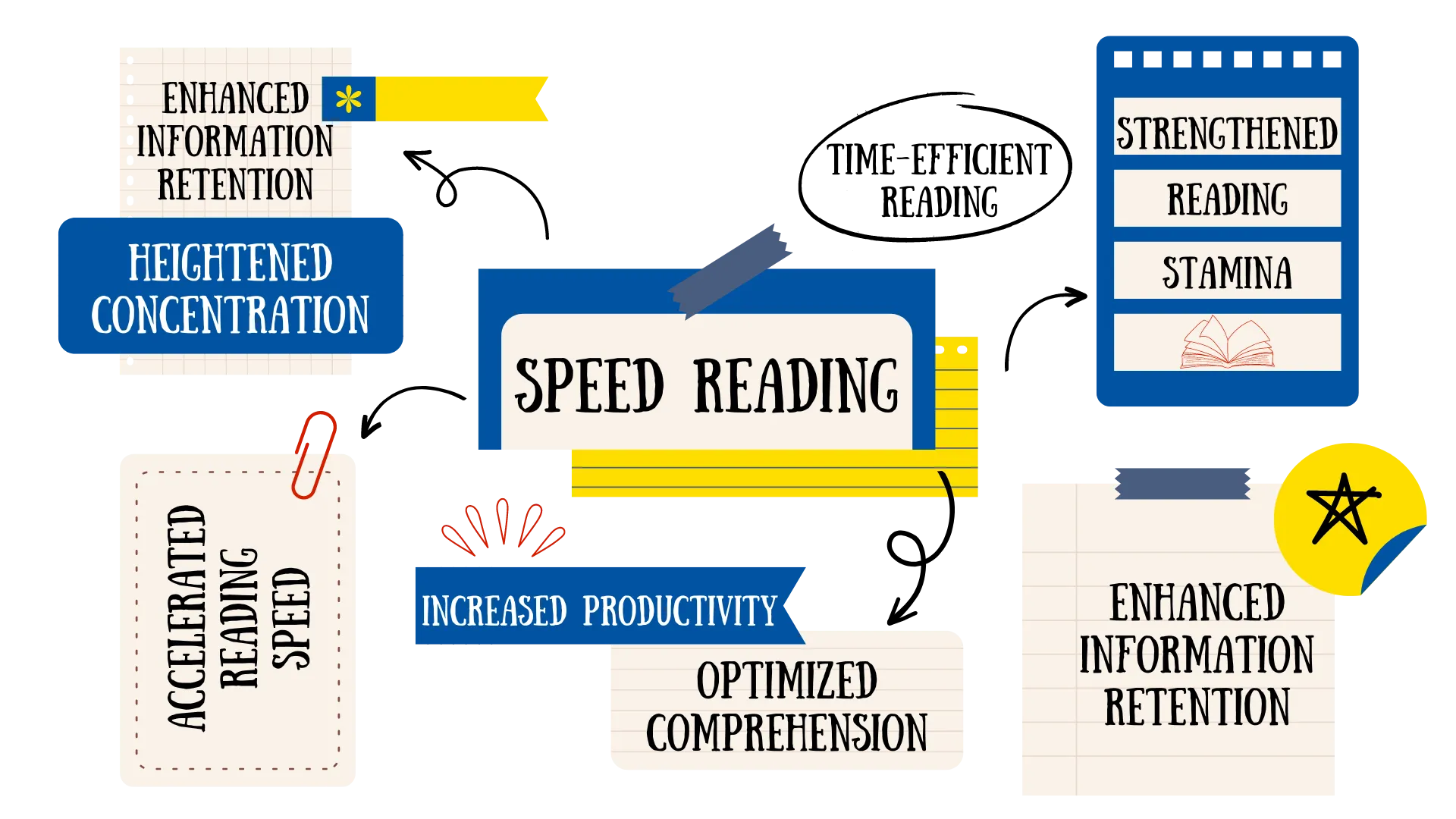
Zooming through pages using Speed Reading
Buckle up, bookworms! Say bye-bye to slow reading – it’s time for a fast and fun reading adventure. Speed reading is like strapping on a jetpack for your eyes, taking you on a wild ride through pages. Goodbye slow reading, hello fast-paced excitement where even the story twists can’t keep up with you.

Speed Reading Ninja Tactics
Explore the magic of Speed Reading, where reading becomes a cool ninja skill. Learn tricks to read fast and enjoy every page. Our strategies make reading faster a fun experience. Get ready for a fun adventure that will make speed reading feel like a challenge you can easily conquer!
Consistent Reading Routine
Utilizing Technology
Optimizing Conditions
Tracking Progress
Continuous Improvement
Consistent Reading Routine
Guide students in establishing a regular reading schedule. Discuss strategies for overcoming procrastination and integrating speed reading into daily habits. Encourage the formation of a positive reading routine for long-term skill retention.
Utilizing Technology
Introduce speed reading apps, tools, or online platforms. Guide students on how to use these resources effectively, incorporating them into their practice routine. Discuss the advantages and potential pitfalls of relying on technology for speed reading.
Optimizing Conditions
Provide tips for reducing distractions, improving lighting, and creating a comfortable reading space. Emphasize the role of a conducive environment in fostering effective speed reading.
Tracking Progress
Conduct regular assessments to gauge reading speed and comprehension. Collaborate with students to set measurable and achievable goals. Provide feedback based on assessments, highlighting areas of improvement and success.
Continuous Improvement
Implement a structured practice schedule with varied reading materials. Provide constructive feedback on reading speed, comprehension, and technique. Use progress-tracking tools or journals for students to monitor their development.
Cracking Up Your Way to Page-Flipping Proficiency
A playful expedition into mastering page-turning skills. Our lessons promise a joy-filled ride, turning the challenge of reading faster into a joyful and entertaining experience.

Introduction to speed reading and dispel myths
Brief History and Practical Applications:
Start by exploring a brief history of speed reading and its practical applications, providing context for its development and real-world uses.
Dispelling Common Misconceptions:
Address prevalent myths surrounding speed reading, clarifying that the goal is to enhance both reading speed and comprehension, fostering a clear understanding of its purpose.
Inspiring Confidence with Success Stories:
Share success stories related to speed reading to inspire confidence, showcasing the positive impact it has had on individuals and emphasizing the achievable benefits of mastering this skill.
Pre-Reading Techniques
Effective Scanning Skills:
Instruct students to scan headings, subheadings, and visual aids before reading the main text, helping them to quickly grasp the structure and main ideas of the content.
Purposeful Understanding:
Emphasize the significance of understanding the purpose of the reading, encouraging students to set specific goals—whether to gather information quickly or to delve deeply into key concepts.
Goal-Oriented Reading:
Teach the importance of setting clear goals before reading, guiding students to define their purpose for reading and tailor their approach accordingly, promoting efficient and purposeful reading habits.


Minimizing Subvocalization
Awareness Exercises for Subvocalization:
Conduct exercises to make students aware of subvocalization, encouraging them to recognize and understand the habit of silently pronouncing words while reading.
Gradual Speed Increase in Silent Reading:
Have students practice reading passages silently while gradually increasing the speed, helping them break the habit of subvocalization and promoting faster comprehension.
Visualization Techniques for Concept Grasping:
Introduce visualization techniques to aid understanding, teaching students to grasp concepts without relying on inner speech and enhancing their ability to absorb information at an accelerated pace.
Expanding Peripheral Vision
Widening Focus Exercises:
Offer exercises that involve widening focus while maintaining comprehension, helping students expand their peripheral vision and enhance their overall reading abilities.
Encouraging Peripheral Awareness:
Foster peripheral awareness by guiding students to explore visual information beyond the central reading point, promoting a broader field of vision for more efficient reading.
Online Tools for Peripheral Vision Development:
Utilize online exercises or apps specifically designed to promote peripheral vision development, providing practical tools that students can use to enhance their peripheral awareness and speed reading skills.


Breaking the habit of rereading
Understanding the Impact of Regression:
Discuss the negative effects of rereading, emphasizing how it hinders reading speed and overall comprehension.
Techniques to Prevent Regression:
Teach practical techniques, such as using a pointer or finger to guide the eyes forward, to prevent the habit of backtracking and encourage a continuous flow of reading.
Engaging Exercises for forwarding Momentum:
Incorporate engaging texts and a variety of exercises to reinforce the importance of forward momentum in reading, encouraging readers to break the habit of rereading and maintain a steady pace.
Techniques for quickly assessing content
Skimming and Scanning Differentiation:
Teach the distinction between skimming and scanning, illustrating when each technique is appropriate for efficient content assessment.
Identifying Keywords, Headings, and Summaries:
Provide examples and guidance on quickly identifying keywords, headings, and summaries to streamline the process of grasping the main ideas in a text.
Practical Exercises for Skimming and Scanning:
Incorporate hands-on exercises where students practice skimming to capture main ideas swiftly and scanning to locate specific details, reinforcing their ability to quickly assess and comprehend content.


Grouping words for faster processing
Introduction to Chunking:
Introduce the concept of chunking, which involves breaking down content into meaningful groups to facilitate quicker processing and understanding.
Grouping Exercises for Identification:
Conduct practical exercises where students actively identify and group related words or ideas within texts, honing their skills in effective chunking for faster reading.
Illustration with Varied Texts:
Use diverse texts as examples to illustrate how the technique of chunking enhances both reading speed and comprehension, showcasing its applicability across different types of content.

